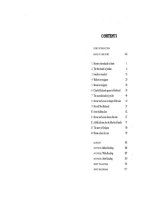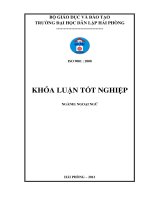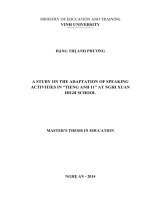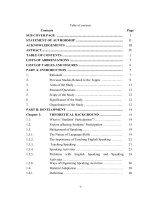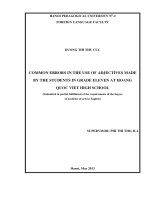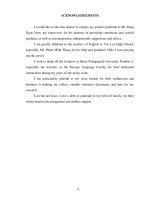Some effective techniques to encourage the students in basic classes 11 to speaking lesson through lesson two of unit 6 in tiếng anh 11
Bạn đang xem bản rút gọn của tài liệu. Xem và tải ngay bản đầy đủ của tài liệu tại đây (1.22 MB, 18 trang )
TABLE OF CONTENTS
Table of contents
A. INTRODUCTION
I. The reason of selecting the topic
II. Objectives of research, research tasks,
methodology and scope of research
1. Objectives of research
2. Research tasks
3. Research methodology
4. Scope of research
B. CONTENT
I. The reasoning basis of the theme
II. The real situation of the matter.
1. The real state
2. From this consequence, we can see that
III. Measure implementation
1. Dividing groups and assigning their task at home
2. The distribution of the speaking lesson
2.1 Pre- speaking strategies
2.2 While – speaking strategies
2.3 Post – speaking strategies
IV. The result of researching
1. About the theory
2. About the fact
C. CONCLUSION AND PROPOSAL
I. Conclusion.
II. Proposal.
Pages
1
2
2
research 2
2
2
3
3
3
3
4
4
7
7
7
8
9
12
12
13
13
15
15
15
16
A. INTRODUCTION
1
I. The reason of selecting the topic
While a picture may be worth a thousand words, those words will no
doubt come in handy if the picture is distorted or poorly understood. After all,
the most effective way to communicate is through speech.
The four language skills of listening, speaking, reading, and writing are all
interconnected. Proficiency in each skill is necessary to become a well-rounded
communicator, but the ability to speak skillfully provides the speaker with
several distinct advantages. The capacity to put words together in a meaningful
way to reflect thoughts, opinions, and feelings provides the speaker with these
important advantages. Here are some of the specific reasons why English
learners are encouraged to speak in English- that’s why in Program Framework,
Grade 11 textbooks; speaking is secondly taught to help students get knowledge
in learning other skills such as: reading, listening and writing. Moreover,
throughout the world today, and especially in developing countries, there is a
great need for people to speak English well. Many employers look for English
speakers smoothly. So it is important for students to learn to speak English and
for teachers to know how to teach speaking well. In addition to, many teachers
are already very good at teaching vocabulary and grammar in order to prepare
students for examinations. However, organizing lessons to practise speaking
English can be a big challenge for both teachers and students . In this situation, I
try my best to find out effective methods to improve student’s speaking skill and
I choose Unit 6 – speaking in Tiếng Anh 11 to make my experience initiative
“SOME EFFECTIVE TECHNIQUES TO ENCOURAGE THE
STUDENTS IN BASIC CLASSES 11 TO SPEAKING LESSON
THROUGH LESSON TWO OF UNIT 6 IN TIẾNG ANH 11” in order to
gain the best lesson and help students improve their speaking skill.
II. Objectives of research, research tasks, research methodology and scope
of research
1. Objectives of research
a. For the students
In this topic, I mainly focus on the actual subjects of basic class 11 and
introduce students know how to learn and gain speaking skill, through some
steps in learning procedure, students not only understand effective and have
suitable methods, but also apply those to fact situations in the life
b. For the Teachers:
Find out the most effective methods to improve students’ speaking skill
and know how to stimulate students to speaking lessons naturally. Besides,
teachers also draw from valuable experiments in making suitable lesson plans
for different learners in each period.
2 . Research tasks
The purpose of research is to discover answer to questions through the
application of scientific procedures. The main aim of research is to find out the
2
truth which is hid and which has not been discovered as yet. Through this
research I mention two main tasks:
- Find out the actual situation of students’ attention to speaking lesson and
academic research of practicing communication skill effectively.
- Apply my research to teaching practices, then compare, contrast the
implementation of a topic. And teachers evaluate and conclude the effectiveness
of topic.
3. Research methodology
- It’s a way to systematically solve the research problem. It may be
understood as a science of studying how research is done scientifically. In this I
study the behavior and instruments I use in performing research operations such
as making observations, recording data, techniques of processing data and
others. Research methods refer to the information used in selecting and
constructing research technique such as analysis of documents, questionaires,
focused and group interview, survey, comparison and evaluation. All those
methods which are used during the course of studying my research problem are
termed as research methods. Since the object of research, particularly the
applied research, it to arrive at a solution for a given problem, the available data
and the unknown aspects of the problem have to be related to each other to make
a solution possible. Keeping this in view, I focus on:
+/ I concern with the collection of data which is available without being
sufficient to arrive at the required solution;
+/ I use statistical techniques which are used for establishing relationship
between the data and the unknown
+/ I also apply the methods which are used to compare and evaluate the
accuracy of the results obtained.
4. Scope of research
The scope of study for a research paper is usually one of the first sections
to the project. It sets out the scope of my work and limitations, so I mainly focus
on two aspects:
+/ It’s about effective methods to teach Unit 6 – B. speaking in English
book 11 .Through this lesson, students know how to acquire speaking skill.
+ I apply my search to students in grade 11 such 11 A2 and 11 H2 in Trieu
Son 3 high school.
B. Content
I. The reasoning basis of the theme
According to experts such as MC Gee (1977), Thornis (1980), Havernson
& Haynes (1982)........English teachers need to focus on effective factors of
successful speaking lessons such as: students’ attention to the lesson, ability of ,
acting on a knowledge of grammar and vocabulary and ability of working
individually, in pairs or in group. However, fast or slow results depend on
students’ understanding in mother tongue, health, and acumen in audiovisual
capability. Moreover, a number of impacts other elements come to learner’s
3
unevened apprehension leveling. Therefore, teachers need a concrete orientation
in speaking such as teaching students ways how to use the language and
communicational situations. Most students are afraid of making mistakes in
pronunciation. Therefore, they do not like speaking or join speaking
lessons. On the other hand, they only focus on doing tasks in textbook and not
applying to practical situation.
Inferential capability, understanding and exposition to concepts such as
words, phrases, and sentences which can impact effectively on reading. How to
understand lessons thoughtfully depends on students’ ability in learning a
language.
In short, to gain a high result in attract students to speaking skill, teachers
need flexibly not only classify students properly and find out effective methods,
but also make up different situations which help weak students and stimulate
strong ones in a speaking period. Teacher should combine other skills such as
speaking, writing in order to make lesson become attractive and interesting.
II. The real situation of the matter.
1. The real state
Speaking is "the process of building and sharing meaning through the use
of verbal and non-verbal symbols, in a variety of contexts" (Chaney, 1998, p.
13). Speaking is a crucial part of second language learning and teaching. Despite
its importance, for many years, teaching speaking has been undervalued and
English language teachers have continued to teach speaking just as a repetition
of drills or memorization of dialogues. However, today's world requires that the
goal of teaching speaking should improve students' communicative skills,
because, only in that way, students can express themselves and learn how to
follow the social and cultural rules appropriate in each communicative
circumstance. In order to teach second language learners how to speak in the
best way possible, some speaking activities are provided below, that can be
applied to ESL and EFL classroom settings, together with suggestions for
teachers who teach oral language.
Although English became one of the official subjects at school, but
promoting its benefits has not been much interested, partly because the facilities
are not high and don’t attract students’ passion for learning increasingly. Some
teachers complain that most students are not able to confide in communication
. Reason why students don’t enroll speaking activities in each lesson – students
hate to speak, they only answer the questions required in each task of the
textbook. Students lacked motivation to solve situation in the life, even if the
teacher give questions or cooperation, they show negative attitudes. For most of
the learners, speaking is an extremely difficult task that requires integrated body
of skills, which also does not get easier with the practical situation and the
accumulation of experience.
Teachers have an important role to improve speaking skill to their
students to improve other language skills. They can follow some stages and
4
strategies when teaching this skill because speaking strategies are considered as
the mental operations involved when teachers approach a text effectively and
make sense of what they read. However, some teachers have not applied flexibly
theory into practice; have not integrated properly skills together in lesson, and
innovative methods which are not suitable for the students. That’s why the
quality of the lesson is not effective and reduces.
During my teaching process in Trieu Son 3 high school, I must look at
actual issues in learning speaking skill of students in basic class 11 is very badly.
Students aren’t interested in this skill. As you can see in this convey in basic
classes 11 such as 11B2 and 11B1;
Disadvantaged factors
Percentage (? / 100%)
1. Topic: - Most topics are strange to 70 %
basic students; their content is complex
and boring.
2. Tasks and activities: - They are 55%
often
suitable
with
students’
knowledge. Some are too difficult and
strange, and others are shortage of
realistic.
3. Words and structures: - Students
are in trouble with a lot of new and 80 %
complex words or structures in one
text.
4. Students’ habit in practicing
speaking skill: - Only answer 90%
questions in the task and be lazy in
creation of the communication skill.
- Students also try to write without
speaking
5. Students’ belief: - Most students are 77 %
afraid of making mistake (pronounce,
rhyme, wrong answer) or getting
communication problems.
6. Teaching aids: - Most classes lack
of teaching aids.
43 %
- Teachers aren’t interested in teaching
aids of each period.
Moreover, there are some disadvantages in applying unsuitable methods,
skills to each lesson. If it happens in a long time, it will affect to students’ ability
in a language class and make them passive, lack flexibility, afraid to make a
conservation.
5
For example, in Unit 6 – B. speaking in Tiếng Anh 11;
Teacher and students’
contents
limitations
activities
1. Before you speak
- Most students used
Teacher: - Ask students to Questions: - Which of the answers in reference
give their opinions?
competitions / contests book.
Students: - Give opinions below do you like or -These
questions
dislike?
aren’t attractive to
- Why?
start a lesson.
Teacher: Give useful
- Time- consuming.
language
2. While you speak
- Students feel bored
I Like......., but I don’t 1. Task 1: Choose A, B, or and lazy.
like..............
C that best suits the -Task only suits some
Students: - Listen and meaning of the italicized students in the class.
copy down their notebook word.
- It is similar to
reading lesson.
Teacher: - Ask students to
work in pairs.
- Give useful language
Students: - Work in pairs.
- Give answers and
questions
-Teacher: Ask students to
work in group.
- Give some instructions
to the lesson
- Ask students to give
answer
- give a comment
-Students: Raising their
hand to talk.
2. Task 2: Ask their partner
how he /she feels about
each
type
of
the
competitions.
* What do you think of the
general knowledge Quiz?
- Only stimulate
some strong students.
- Only weak students
are afraid of making
mistake
or
not
understanding their
partner’s ideas
3. After you speak
-Talk about a competition or
contest.
1. Where and when did you
see or take part in it?
2. What type of competition
or contest?
3. Who organized it?
4. Who participated in it?
5.
Who
won
the
competition?
6.
Who
won
the
competition?
7. Did you enjoy it?
- Students aren’t selfconfident enough to
make a dialogue .
- The atmosphere of
the class is serene.
- Only gift students
are eager to speak
English.
- Everything seems to
be a model.
Through my votes in the investigation and table of early year( 2015 -2016) in
class 11B1, 11B2, the percentage of basic students’ result in ending the reading
lesson of unit 6 as follow: Class 11B1
6
Class sizes Good
44
0 = 0%
- Class 11 B2
Class sizes Good
Above
average
03 = 6,8 %
Average
weakness
poverty
15 = 34,1% 20 = 45,5 % 06 = 6,8 %
Above
Average
weakness
poverty
average
43
2= 4,7% 15 =34,9 %
18 = 41.9% 5 = 11.5 % 03 = 7%
2. From this consequence, we can see that:
From results of the current situation, I give some effective methods to
help students have a good speaking lesson through part B in Unit 6
(competitions) of basic English 11. I also show students that speaking is an
interesting and important lesson. Students will not be under pressure of
studying. And I realized good results in basic classes I apply my new methods in
school year 2015- 2016. Students gradually know how to prepare a speaking
lesson, performing and applying to other skills. Each period, students discover
new things for them. In each period, students feel confident and comfortable in
giving ideas, creation and apply it to practical situations in the life.
III. Measure implementation
1. Dividing groups and assigning their task at home
a. Way to perform:
After finishing reading lesson, I will divide the class into four groups to
prepare for the next lesson: Unit 6 – B. speaking. Each group will make a
discussion about the title of the next lesson. There is no limit in their
preparation.
Teachers will observer students in learning process to classify each group at the
same level correspondence. If students pay attention to the lesson, prepare the
lesson well, involve in activities positively and have a lot of creation in each
situation, they will be added good marks in their tests’ mark. In contrast, if any
groups ignore their task, they will be added bad marks in their test’s mark. In
sum, except for final first or second term test‘s mark, I will divide final mark
total into two part: 80 Percent in the test and 20 % in learning process.
b. The effect of this formation
- For the Teachers: It will reflect exactly students’ ability in the class.
Discussion in group will help students feel more self –confident in speaking
English among their friends as well as others. Stimulating students to creation to
make role-play in order to solve situation in the life better. In addition, it is easy
to comprehend the lesson without following a rigid model.
- For the Students: They will have to prepare lesson carefully, raise their hand
to answer questions from the teacher, take in the activities sympathetically and
pay attention to the lesson if they want to be added good marks. Of course, they
will feel more confident in communication and giving their own ideas or
7
answers. It also makes students aware of how the importance of language
learning is.
2. The distribution of the reading lesson
I divide the lesson into three main stages and distribute time properly to
gain a high result. The stages and strategies of speaking that I should promote
for my students are: - pre-speaking, while speaking and post speaking stages.
These stages are very important when teaching this skill, each of these ones has
its own characteristics, although they are related to one another. That is, the prespeaking stage leads to the while-speaking stage and finally to the post –
speaking one. These stages make the students understand and improve speaking
skill.
Teacher introduces some competition on TV and asks students which one they
like best. And then, I ask them some questions relating to the lesson.
1. Which competition do you like best on TV?
2. Why do you like it?
3. If you had a chance to participate in a competition on TV, Would you like to
join it?
After listening to their answers, teacher gives comment and uses these
questions and answers to lead in new lesson.
b. The effect of the activity.
In a short time, I can introduce some competition on TV and also attract
students to the lesson better. In addition, students guess the content of the lesson.
2.1 Pe- speaking strategies:
Teacher can enable their students to understand a speaking text by giving
useful language. Thanks to this, students can apply them to their speaking. This
stage also helps to make the next stages of speaking more easily adaptable to
students. Therefore I must find out the best way to start an effective speaking
lesson.
In this part, I divided into two parts: Brainstorming and providing
students some vocabulary and structure to raise their speaking abilities.
a. Brainstorming
- In this part, I want students to think some things relating to the lesson in order
to help them feel comfortable and understand speaking title more.
Sao Mai
Television Singing
Contest
Wheel
of
fortune
GAME SHOWS
ON TV
The price is right
Olympic
Games
8
-
b. Teaching vocabulary
It is very important for students to learn vocabulary. Students might even
have a receptive knowledge of a wider range of vocabulary, which means they
can recognise the item and its meaning. Nevertheless, their productive use of a
wide range of vocabulary is normally limited, and this is one of the areas that
need greater attention. At this stage we are concerned not only with students
understanding the meaning of words, but also being able to use them
appropriately, taking into speaking lesson effectively. In addition, I also ask
students for words or sentences which can provide then in the process of
speaking. I read and ask students to repeat, then I check the pronunciation of the
whole class and two students
For example:
- Native speaker (n):
Người bản ngữ ( translation)
General knowledge Quiz : Cuộc thi kiến thức chung
Athletics Meeting :
Cuộc thi điền kinh
Observe (V):
Quan sát
Cheat ((n):
Trò lừa bịp.
+/ Cheat someone out of + N :
Lừa ai để lấy cái gì.
Achieve (v):
Đạt được
Aim: To pronounce word exactly and provide students words to practice tasks
and understand the content of speaking text. By this way, students can get a
deeper and better understanding of the meaning and the use of the vocabulary.
c. Checking vocabulary
I use pictures to check new words students have just learned. I call some
students give a sentence contained a new word.
For example:
1. At center, we can speak to native speakers to improve English.
2. To achieve a higher result, both teams must complete five activities in all
=> Aims: students can get a deeper and better understanding of the meaning and
the use of the vocabulary.
2.2 While-speaking strategies
The speaking activities of while-speaking stage help to encourage critical
thinking of students and increase comprehension an easy retention. This stage
9
includes two activities. Firstly, the teacher will give some small talks to make a
model. This can help students know how to start or finish a conversation. For
example: Hi everyone, I am Lee, welcome to my program, “Sao Mai Television
Singing Contest” . This part, I always encourage students ask me problems they
faced at home. From these complications, students will learn more in the fact.
They can know how to solve communicational situations in the life. Secondly,
Students will show their preparation at home to others in the class and the
teacher observes and gives comments. There are many ways to form in this stage
such as: Giving opinions, discussing, matching, ask and answer. However, I only
focus on two main points:
a. Give instructions to help students understand more
Students need to learn how to understand situations in the life without
basing on paper. Moreover, don’t make students feel bored with model
conversations which are far from the reality. To have this, teacher needs to make
a suitable lesson plan, use tasks relating to the title, but it has real situations.
That is why I adapted tasks in textbook to give students free subjects
For example:
1. Task 1: Page 69 in textbook ( Tieng Anh 11)
This is a model task. It is simple, but boring. Students will do this task without
having any difficulty. They only speak or write “like” or “dislike”. Supposing
that they didn’t know anything about Art Competition, they could choose “like”.
Simply, they needn’t give any explanation for their choice or answer. Therefore,
I change this task to suit students’ ability and make the lesson become more
attractive by making a short dialogue.
Eg: A short dialogue between Dao and Lan to ask for another option
10
- Only after students speak some English sentences will they feel better in
communication than in repeating of traditional style. Students can apply this
way to their daily lives.
Eg: We can speak English with a native speaker.
Lan: Hello
Peter: Nice to meet you.
Lan:: Do you like the weather in Viet Nam?
Peter: Yes. I like. It is wonderful
Task 2: Page 69 in textbook ( Tiếng Anh 11)
In general, Most teacher ask students to work in pairs. Using some adjectives to
complete a conversation basing on a model one.
Eg: A: What do you think of the General Knowledge Quiz?
B: Oh, It’s great. It’s an opportunity to test my general knowledge.
As you knew, if students only practise their Speaking skill by this way, they
can’t know how to react in real situation. They do not have a communication
environment, which is the main reason behind the ineffective teaching and
learning of English. As a result, students have become afraid of learning
English.
To improve this issue, I adjusted this task to help students have confidence in
communication.
- I set students in daily life and practise their interrogatives
11
In my opinion, we also need to keep in mind the fact that communication is a
two - way process. Not only does it make you seem uninterested, even rude if
you don’t ask questions, you might also end up being the one who has to do all
the talking. So, when you’ve run out of ideas about what to say next, remember:
others might have something to add.
+ What are you views on that?
+ How about you? What do you think?
+ Why do you think it is so great?
Questions like this will keep the conversation going and will show your interest
in other people’s opinion. They will also give you time to relax a little and start
enjoying yourself.
Eg: Jane: Have you ever taken part in any competitions or contests?
Kate: No, I haven’t . I only watch them on TV.
Jane: So, Which competition do you often watch?
Kate: Oh, “Arena 100”
Jane: yeath, What type of competition is it?
Kate: uhm, It is General Knowledge Quiz.
Jane: yes. Ah, What do you think of the General Knowledge Quiz?
Kate: Oh, it’s great. It’s an opportunity to test my general knowledge.
Jane: I think so. And do you want to take part in it?
Kate: May be, If I have a chance, I will do. And you?
....................................................................................
This conversation will continue longer and longer. It makes students feel
confident and talk freely without being afraid of mistakes in speaking procedure.
** The result of this method:
Students needn’t try best to translate word or understand word’s meaning
in the textbook and immate . This simple activity encourages all students in the
class to the lesson and not time – consuming. After completing this, most
students realise the purpose of the lesson.
2.3 Posting-speaking strategies
Following speaking experience, both formal and informal. It is important to
have students reflect upon their performance . Their reflection , whether it is oral
or written, should include the teacher, who can help them set personal goals for
improving their speaking abilities. This type of reflective accesment and goal
setting encourages critical thought. Some purposes for post-speaking activities
are listed below.
12
There are many ways to form this stage such as: Interviewing, recall the story
or dialogue, role play , summerising the main points, card and discussion.
However, I chose role play and discussion to check their comprehension and
retention of the information of a text that they have already tackled.
Role play in a simulation exercise where persons take on assumed roles in
order to act out a scenario in a contrived setting. The learners or participants can
act out the assigned roles so as to explore the scenario, apply skill (may be
communication, negotiation, debate etc.), experience the scenario from another
view point, evoke and understand emotions that may be alien to them. It helps to
make sense of theory and gathers together the concepts into a practical
experience, so I appreciate this activity because it supply for students’ speaking
skill and make students believe in next lesson : part C (listening ) .
For example: Task 3, textbook, page 70 (Tieng Anh 11)
To make this stage become better, I let students show students’ task prepared at
home. In this activity, I also adapted six questions of “after you speak” in task 3
in the textbook, page 70 ( Tieng Anh 11) . I want students to have real
experience in daily life
Group 1: Quiz Show “ Road to Mount Olympia”
Group 2: Beauty contest
Group 3: Ask “ Xoáy” and Answer “Xoay”
Group 4: Show “The world around us”
(Appendix)
* Method:- Teacher calls each group to express its previous preparation.
- Teacher and other groups observe and give comment
- Ask some questions if it is necessary.
- Teacher correct and give mistakes.
* ** The result of this method:
This way is not only useful as a view, but greatly improves speaking
skills. Through this activity, students will review main and detailed information
and practice their communicational skill.
Students are not in trouble with
doing their task because they had thoughtful preparations. However, Students
not only understand the content, but also knows the aims of the preparation in
order to achieve a complete knowledge. This step helps students believe in their
ability and they will be easy to have any communication with native speakers.
IV. THE RESULT OF RESEARCHING
Through the survey and empirical comparisons conducted, comparing the
results of applying new methods to listening lessons in classes in the 2015-2016
school year 11 B2, 11 B1, shows that:
1. About the theory:
1.1 For the teachers:
Building the teaching methods in the spirit of innovation and appropriate
for the requirements of students. Applying flexible methods and skills or tips to
practical teaching practice, thereby enhancing the quality of teaching subjects.
13
1.2 For the students:
Understand and know how to use proficiency skills, fast and efficient
methods in making a conversation which can be applied to the fact. They are
confident, more interested in finding out information and solving situations in
the daily life
2. About the fact.
The result of tasks, homework, tests after the application of the subject
shows that the spirit of learning and doing all the results of the students
improved a lot compared with applying traditional methods: read, write and
avoid speaking in speaking lesson.
To have a comparable basis and come up with the correct conclusions for
the research process and subject to the applicable practice. I have examined and
collated survey results make all students before and after the application of
subject to the 2 classes: 11 H2 in 2013-2014 school year and 11 A2 in 20142015 school year. (Time to do all 10 minutes)
- Class 11 H2 (The strong class of block 11) has not been applied on topic.
- Class 11 A2(the strong class of block 11) was applied on the subject.
=> The test results of the two classes achieved as follows:
Class
Class Mark 0-4 Mark 5-6
Mark 7-8
Mark 9-10
sizes SL %
SL
%
SL
%
SL
%
11 H2 44
10
22,7 26
59,1 8
18,2 0
0
11 A2 46
4
8,7
12
26,1 20
43,5 10
21,7
And I also give two types of students’ common answers from two class 11 H2
and 11 A2 to show the effect of applying new methods in teaching speaking
lesson and students’ understanding to the lesson as well as ways in which
students To have a comparable basis and come up with the correct conclusions
? Task: Work in groups. Talk about a competition or contest you have
recently jointed or seen. Use the suggestions below.
1.Where and when did you see or take part in it?
2. What type of competition or contest was it?
3. Who organized it?
4. Who participated in it?
5. Who won the competition / contest?
6. Did you enjoy it? Why? Why not?
* Answer worksheet 1: Class 11H2
- Most students write answer on the paper and then they discuss in group and
then one strong representative works as a journalist to interview others.
Journalist: Where and when did you see or take part in it?
Member: Yes, I have. I took part in “ Arena 100”
Journalist: What type of competition or contest was it?
Member: It was General Knowledge Quiz.
Journalist: Who organized it?
Member: A Dutch TV production company
14
Journalist: Who won the competition / contest?
Member: My friend, Nam
Journalist: Did you enjoy it? Why? Why not?
Member: Yes, I did. It was interesting
=> They are really passive in communication. Lack of flexibility when the
journalist only uses these sentences to ask all members in group. Sometimes,
they forgot words and
* Answer worksheet 2: Class 11 A2
- After being taught by new method in speaking lesson, most students are eager
to new lessons than they used to be. Each lesson, students start to become more
self – confident in making conversations, debates and dialogues. They aren’t
afraid of mistakes in pronunciation or making sentences.
- After I give them this task. They thought of making role play. They make up a
competition and each member in group has their own duty.
+ MC: Introduce and hold a program or a competition.
+ Examiner : Observe and give marks as well as comments
+ Participants: Listen to the rule and complete their competition .
+ Audience: Give some questions to consolidate .
In short, Everyone in group can speak English in natural and comfortable mood.
Moreover the atmosphere of classroom becomes interesting .By this way, we
will avoid the traditional teaching method with which students stay passive in
learning and do not have a communication environment, which is the main
reason behind the ineffective teaching and learning of English. As a result,
students have become afraid of learning.
C. Conclusion and proposal
I. CONCLUSION
Speaking is "the process of building and sharing meaning through the use
of verbal and non-verbal symbols, in a variety of contexts" (Chaney, 1998, p.
13). Speaking is a crucial part of second language learning and teaching. Despite
its importance, for many years, teaching speaking has been undervalued and
English language teachers have continued to teach speaking just as a repetition
of drills or memorization of dialogues. However, today's world requires that the
goal of teaching speaking should improve students' communicative skills,
because, only in that way, students can express themselves and learn how to
follow the social and cultural rules appropriate in each communicative
circumstance. In order to teach second language learners how to speak in the
best way possible, some speaking activities are provided below, that can be
applied to ESL and EFL classroom settings, together with suggestions for
teachers who teach oral language. Therefore, we must use the attractive,
appropriate procedure to assist in teaching for students in basic classes 11 to
achieve good results. Moreover, I use Unit 6 – B. reading in Tiếng Anh 11 to
apply some effective methods for speaking lessons and I also hope that teachers
15
should apply different methods flexibly to attract students’ passion to each
speaking lesson more and more.
Classrooms should be places where students can ask and answer
meaningful questions and in which the teacher and students are co- Learns,
collaborating with one another to communicate ideas and information . Different
group sizes (pairs, small groups, and large groups) provide opportunities for
students to practise the different thinking and oral skills unique each
configuration.
II. PROPOSAL
The methods applied in teaching speaking have obtained positive results.
However, there are restrictions in my topic I don’t realize. Therefore, I look
forward to hearing the comments from colleagues, especially the teachers who
teaches English to make my topic more complete and more widely applied
XÁC NHẬN CỦA
THỦ TRƯỞNG ĐƠN VỊ
Thanh Hóa, ngày 9 tháng 6 năm 2017
Tôi xin cam đoan đây là SKKN của mình
viết, không sao chép
Nguyễn Thị Mỹ Lệ
REFERENCE
1. “The Oxford English-Vietnamese Dictionary” (Đặng Ngọc Viễn)
2. TIẾNG ANH 11
3. Http/ speaking method.com
4. “ ENGLISH LANGUAGE TEACHING METHODOLOGY” (Dr. Than
Trong Lien Nhan, Hue University of Foreign Languages
5. Http/ The role of speaking skill in the life
6. Milada Broukal, (2002) – Introduced and annotated by Le Huy Lam.
TOEFL speaking flash. Ho Chi Minh publisher.
16
DANH MỤC
CÁC ĐỀ TÀI SÁNG KIẾN KINH NGHIỆM ĐÃ ĐƯỢC HỘI ĐỒNG
ĐÁNH GIÁ XẾP LOẠI CẤP PHÒNG GD&ĐT, CẤP SỞ GD&ĐT VÀ CÁC
CẤP CAO HƠN XẾP LOẠI TỪ C TRỞ LÊN
Họ và tên tác giả: Nguyễn Thị Mỹ Lệ
Chức vụ và đơn vị công tác: Trường THPT Triệu Sơn 3
Kết quả
Cấp
đánh
đánh giá Năm
học
giá xếp loại
TT Tên đề tài SKKN
xếp loại đánh giá xếp
(Phòng, Sở,
(A,
B, loại
Tỉnh...)
hoặc C)
1.
Some effective methods to Sở GD & ĐT C
2014
encourage the students in
basic classes in basic classes
10 to reading lesson through
lesson one of unit 16 in Tieng
Anh 10
17
18
